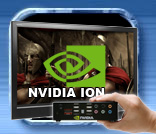Introduction

NVIDIA ION, Intel's Atom gets acceleration
 If there is one thing in the past 10 years or so that I've been in this hardware review business, that has persistently amused and amazed me, has to be seeing computer technology getting faster and faster, yet each year smaller.
If there is one thing in the past 10 years or so that I've been in this hardware review business, that has persistently amused and amazed me, has to be seeing computer technology getting faster and faster, yet each year smaller.
I can remember last year back at the NVIDIA campus where we where shown Tegra .. a chip the size of the top of your pinky, yet capable of decoding a 720p and even 1080P video at merely a Watt or two three. That is the future, things get faster, smaller, more efficient and more visual. And it's that last word where I have to hook into, as in the past 3 years this industry made a move towards what we call visual computing. Visual computing is a combines and entails everything from gaming, to standard or high-definition playback, medical solutions, computing visual data over the graphics processors and just so much more then just a couple of words can describe.
In that whole trend of things getting smaller and more efficient one of the biggest up and coming platforms that reached the masses was the netbook. An efficient little notebook that allows you to handle basic stuff, like Microsoft Word, simple spreadsheets, checking your email or of course browse the web. But that's where these devices end as they run out of juice to do things at a higher level. And it's in that success where NVIDIA is going to invest as well, today with the release of their ION platform.
What NVIDIA has done with the ION is to create a platform that combines a GeForce 9400M chipset with an Intel Atom processor, all placed on a Pico-ITX PCB. If you aren't familiar with the form factor, that doesn't say much, but imagine you can actually fit the entire PC inside one of your pockets as it's the surface size of roughly a HDD, or even two pears.
With ION, NVIDIA developed something what I like to call CPU compute assistance. A chip that will help the CPU offload some of the specialized tasks. And you can guess it already .. it's an integrated GPU motherboard chipset, the GF9400 chipset. The advantage here is by using such a chipset the environment (PC) will instantly gain modern features and the sheer influence of a GeForce graphics processor.
Think about it, take the average netbook and ask yourself what are the most common limitations ? Yes, high-definition and even DVD playback, games, overall performance. So that's where NVIDIA will jump in to try and make that experience better. It's called NVIDIA Ion, which is the basis for a number of products it could be used in, and it's creepy small.
ION will be a low cost CPU assisted solution that will allow this industry on very short notice to have netbooks with full HD playback quality, in full 7.1 HD audio. A solution that even supports CUDA and therefore some simple PhysX function, but since it's CUDA compatible, it'll also allow encoding of video. A platform that supports Gigabit Ethernet, dual-link DVI (high resolutions monitors), acceleration in Photoshop CS4 and heck .. you can even play a couple of games or make a mini HTPC out of it, really interesting.
Today we bring you a small article slash preview to introduce you the NVIDIA ION technology. A preview at most, based on a small prototype NVIDIA ION reference PC combines the NVIDIA GeForce 9400M GPU chipset + Intel Atom CPU.
Have a peek and try to grasp how big the technology is we are chatting about today.
 Oh, I wasn't joking about the pears in the 4th paragraph ...
Oh, I wasn't joking about the pears in the 4th paragraph ...
